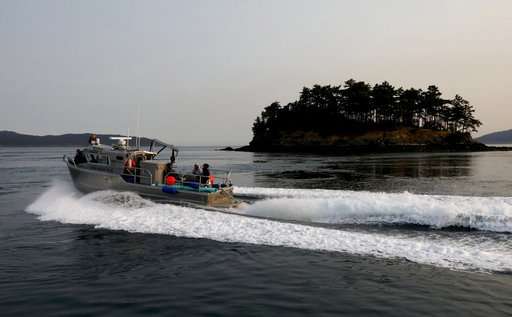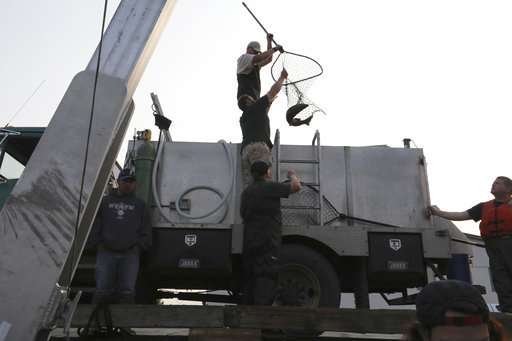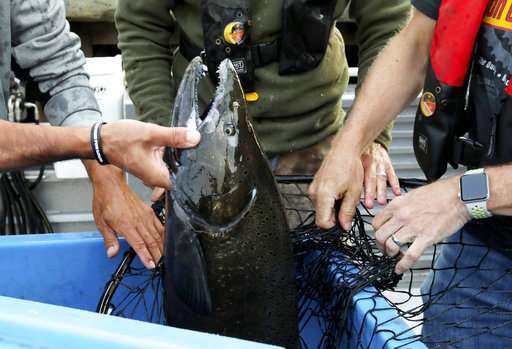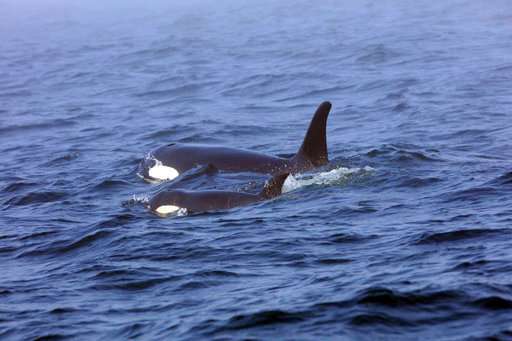Teams pack boats with fish to prepare to feed ailing orca

Teams taking drastic measures to save a young, ailing killer whale loaded up two boats with live fish and rushed to waters near an island off Washington state Friday, preparing if needed to feed the critically endangered orca a day after injecting it with medicine.
But by early afternoon, it appeared the 3½-year-old female orca known as J50 was too far north in Canadian waters and that any trial feeding effort would not happen Friday, said Brad Hanson, a wildlife biologist with the National Oceanic and Atmospheric Administration who is leading response efforts on the water.
The team led by the U.S. agency lacks a permit to feed the sick whale live salmon in Canadian waters, though it had one for medical treatment. NOAA would apply for the feeding permit if conditions are right, said Lynne Barre, NOAA Fisheries' recovery coordinator for the whales.
The team will decide in the field whether to feed the orca, which is emaciated and possibly suffering an infection, depending on a number of factors, including the animal's behavior and location, Barre told reporters.
With the whale not close by, crews did a practice run for the feeding, sending salmon through a turquoise tube off the back of a boat. Researchers with the Whale Sanctuary Project took a sample of the fish scales so they can later genetically track whether the whales consume that fish, while other crews with the Lummi tribe scooped the salmon out of a large bin and sent it into the water.

The whale was given a dose of antibiotics from a dart Thursday, and a veterinarian was able to do a health assessment. Marty Haulena, head veterinarian at Vancouver Aquarium, thinks about half of the dose went into the young orca.
He says the whale is incredibly skinny but was swimming well and there were no obvious signs of abnormality with her skin. They didn't observe whether J50 had been eating or not.
It was dramatic how thin she was, Haulena said, adding that he wants to know more about her digestive system and whether she's been eating.
He said she's breathing normally, taking deep dives and easily keeping up with her group, so respiratory disease is falling down the list of concerns. The team of experts who followed the whale on the water for about six hours Thursday got a breath sample to analyze whether she might have bacteria or fungus in her airway.

The young whale is one of just 75 of the fish-eating orcas that frequent the inland waters of Washington state. There hasn't been a successful birth since 2015.
They face nutritional stress over a lack of their preferred food source, Chinook salmon, as well as threats from toxic contamination and vessel noise and disturbances that disrupt their ability to communicate and forage.
Another female orca in the same pod has triggered an international outpouring as she clings to the body of her dead calf that died two weeks ago. Scientists are worried about her and will watch her but don't have plans to help her or remove the calf. She was last seen Thursday still carrying her calf.
The last time scientists rescued a killer whale in the region was in 2002 when a northern resident killer whale known as Springer was found swimming alone in Puget Sound.
Experts say Springer's case was different because she was isolated. She was moved into a floating net pen and veterinarians assessed her medical condition and treated her. She was fed live salmon in the pen. She returned to her family of whales in Canada later that year and in 2013 was seen with her new calf.

© 2018 The Associated Press. All rights reserved.




















